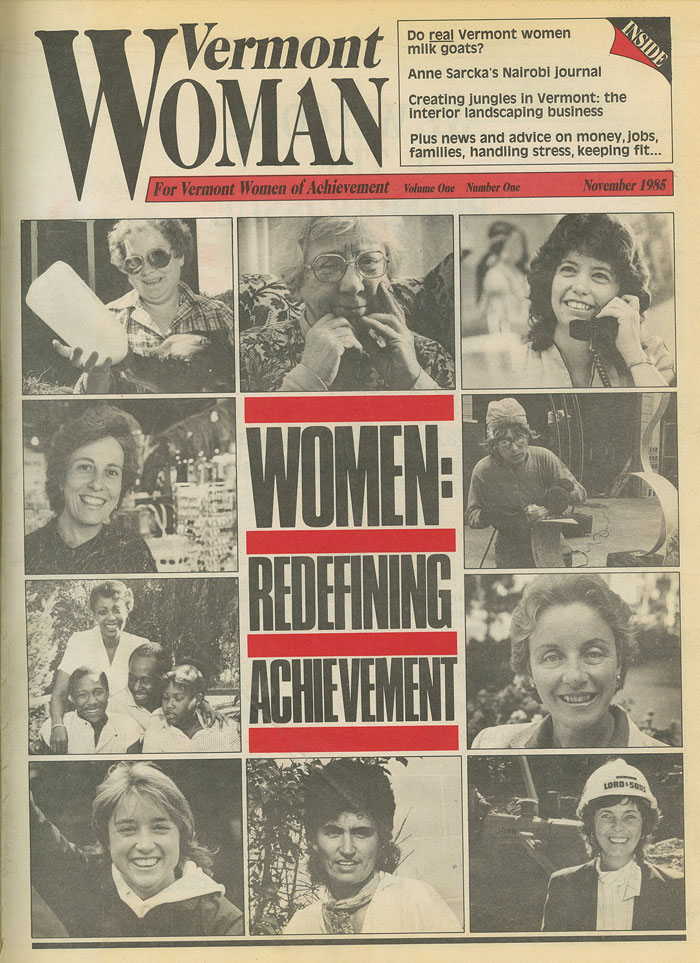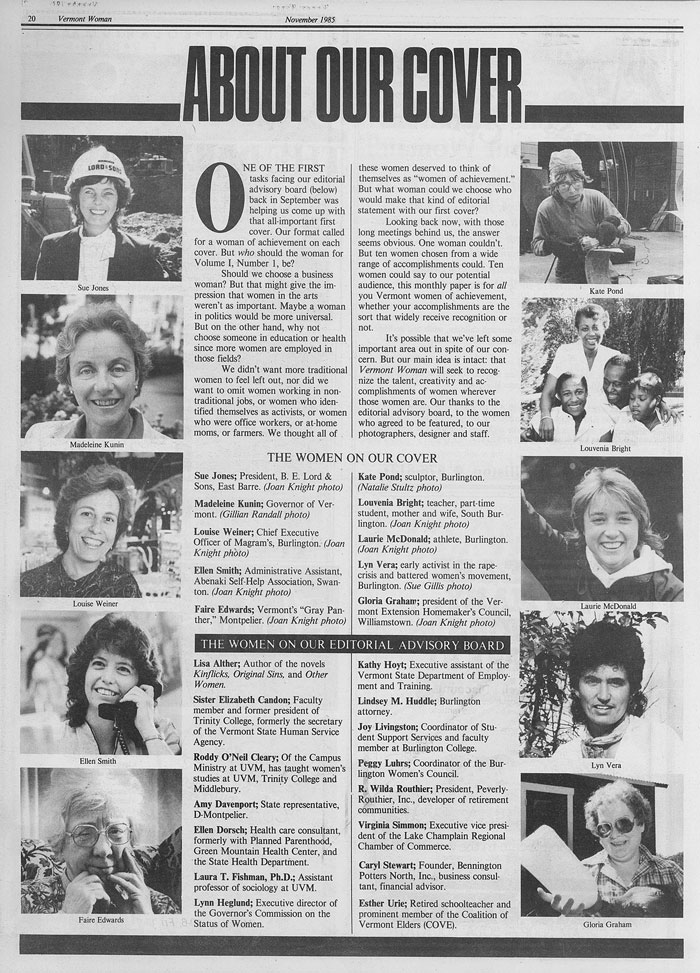
| Ten Vermont Women of Achievement, Then and Now | |
| by Cynthia Close | |
In November 1985, Sue Gillis launched Vermont Woman, with Rickey Gard Diamond as founding editor. At that time, the paper carried a subtitle: “For Vermont Women of Achievement,” chosen by Gillis. Diamond said she expressed her concern to Gillis that the publication would only focus on the traditional version of success: well-coiffed upper-middle-class women in business suits, valuing only money and status. But no, Gillis also believed that achievement meant a great deal more than that, and so “we titled our first cover ‘Women: Redefining Achievement,’” said Diamond. In remembering that decision-making process, she said, “We found [achievement] meant different things to different women, and so the cover includes a woman farmer and an athlete and a mom with her family and a teacher, an artist, and more than one activist—women of many shapes, sizes, colors, and ages, including our first female governor. It still makes me smile when I look at it.” The 15 women of the original editorial board generated the idea of many photos on the cover and came up with suggestions for categories and particular women, with Gillis and Diamond making the final determination of who would be honored as women of achievement. By casting a wide net, they were able to present well-known women like Madeleine Kunin from the political arena alongside Ellen Smith, an administrative assistant with the Abenaki Self-Help Association. The cover communicated to the potential Vermont Woman audience that the publication would practice inclusivity and that all women would be valued for the kind of work they did, whether it be in business, sports, the arts, education, politics, or the home. That philosophy has been maintained throughout the past three and a half decades, through a series of editorial and staff changes and a changing sociocultural environment. The one constant has been the guiding hand of founder Gillis, whose integrity and tenacity to continue publication of a newspaper for and about women has survived personal, political, and technological upheavals. Technology has played a pivotal role not only in the evolution of print media but also in every aspect of our professional and private lives. Home computers were not yet in wide use in the mid-1980s when Vermont Woman launched. There was no Internet as we know it, no e-mail, no Facebook or Twitter, and no cell phones.
|
|
 |
|
 |
|
 |
|
|
Each of the 10 women featured on the cover of that first issue exuded the kind of positive energy that comes from doing. They all appear to be caught in the middle of some moment of action, not formally posed in anything hinting at a corporate setting. Taken as a group we first note their diversity in age from the white-haired, Montpelier-based Gray Panther to the youthful face of Burlington athlete , who appears to be waving at us in a moment of joyful victory. Vermont Woman decided to track down these 10 women and find out, as best we could, what they had done over the past 30-plus years and where they are now. Some of the women featured back then adapted to the evolving cyber environment. They utilized new opportunities to establish their presence in this expanding digital realm. Others felt no need to engage with technology. Perhaps the kind of work they did allowed them the flexibility to circumvent the revolution computers had wrought. This situation presented a challenge in locating and identifying those women whose work and life avoided the scrutiny of anyone outside their coworkers, friends, or family. In 1985, already had established a national reputation and has remained in the public eye. She has earned an extensive profile on Wikipedia, having actively served as the 77th governor and the first and only female governor in Vermont from 1985 until 1991. She was also the US ambassador to Switzerland from 1996 to 1999. At the age of 85, she remains a larger-than-life figure in Vermont and beyond. A year ago, Brattleboro’s Green Writers Press published Kunin’s second memoir, Coming of Age: My Journey to the Eighties. It was shortly after her second husband’s death. At this stage of her life, having retired from her role as a politician, she is more confident in discussing in print her intimate, deeply personal revelations about love and sex, aging and death. Kunin currently lives in the Wake Robin retirement community in Shelburne. was wearing a hardhat in her 1985 photo when she was president of B.E. Lord & Sons, a construction company doing commercial and residential excavation work and asphalt paving. A general search turned up information on the death in 2014 of Robert P. Lord who had worked with his father, the founder of B.E. Lord and Sons. This was the only information generally available about the company. No news was found related to the time period of the mid-1980s when the photo of Jones was taken for Vermont Woman. Jones seems to have faded into obscurity. Her name, being so common, made an Internet search an overwhelming challenge. She, along with athlete of Burlington, left no digital markers to follow. McDonald’s past or present situation is a mystery that might only be solved with a much greater investment of time, money, and resources than was available for this particular project. Like many other women who were instrumental leaders in their own time McDonald’s legacy may only be judged by those who remember her. , formerly an administrative assistant with the Abenaki Self-Help Association, is now Ellen Morgan, living with her husband on 26 acres in Franklin, Vermont, not far from the Canadian border. Recently retired from a career of administrative work for the state of Vermont, she has avoided establishing a life online. Thanks to having a home phone listing for her, I was able to call and briefly discuss how her life has evolved over the decades since 1985. She could barely recall the recognition she received back then. In her modesty, she told me her home and family provide all the recognition she needs: “My joy is my grandchildren and taking care of babies.” She and her husband have raised bees in the past and also now maintain a sugaring operation. Last year she proudly shot her first buck, a four-pointer. stood out as the eldest of this group of achievers. She was an outspoken supporter of Vermont’s town-meeting style of democracy and didn’t hesitate expressing herself at numerous conferences about progressive politics, women, and aging. When she was 71, Edwards was quoted by a USA Today reporter in an article titled the “New England Town Meeting and How it Works,” saying, “Why you might as well say God is dead or that all the maples have been struck by lightning as to say the town meeting is dead.” Edwards died on August 4, 1993, at age 81 in East Montpelier. Burlington’s Church Street has long been the hub of retail and the economic engine driving the region. In 1985, just four years after the Church Street Marketplace was declared a pedestrian-only car-free zone, Magram’s was a department store that occupied the historic Stephen D. Hatch–designed 1878 building at 81–91 Church Street. At that time, served as chief executive officer of the store, owned by her father, Barney Magram. Weiner was an active businesswoman and participant in the 1987 12th Grafton Conference, titled “Vermont: Who Are We Becoming?” These conferences, sponsored by the Windham Foundation, served as something of a think tank and generator of ideas to propel Vermont into the future. In 1990, Magram’s closed. Weiner was included in a 2007 book (The Book of Years: Vermonters Tell Stories from Their Lives Fifty Years after High School) about the 50th reunion of the 1957 graduating class from Burlington High School. Weiner, now 80, retired to Florida with her husband, Sheldon Weiner, a professor of psychiatry at UVM, who passed away in 2015. was honored in 1985 because of her position as president of the Vermont Extension Homemaker’s Council in Williamstown. Like Sue Jones and Laurie MacDonald, Graham seems to have left no trail of digital breadcrumbs to her present life. Alternatively, like many other visual artists Burlington artist/sculptor recognized the power the new digital age put in the hands of artists to present their work directly to audiences rather than depending solely on dealers, curators and galleries to market their creative output. Pond, now 81, has built a very successful career and has established her own informative website: http://www.vermontsculpture.com. On this digital platform she has the freedom to introduce herself and exhibit her large-scale corten and stainless-steel welded sculptures, which have been privately commissioned or made for public spaces. Creating her own website has given Pond the control over her image and access to a vast international audience that she may never have anticipated back in 1985. Four years after appearing on the cover of Vermont Woman, South Burlington teacher became the first female African American to be elected to the Vermont legislature. In a 2008 article in the Rutland Herald, state archivist Gregory Sanford indicated that Bright served as a representative of South Burlington for three terms, from 1989 to 1994. Bright’s history was also referenced in the context of a more recent discussion about the campaign of Kiah Morris, who was elected to the legislature in 2014—the second black woman elected to the state legislature and the first from Bennington County. Unfortunately, Morris suddenly withdrew from her 2018 reelection campaign in reaction to racist threats. Bright had deep roots in the local academic community. Her husband was a professor and served as interim dean of the UVM College of Education and Social Services. Her son Bill Bright, a UVM alumna, serves as the director of government relations at the Boys and Girls Club of America. Bright, now 77, lives in Illinois. age 65, is a retired CTE school counselor at Chittenden Central Supervisory Union. Vera was an early activist in the rape crisis and battered women movement. In 2010, YWCA Vermont honored her as a recipient of the Thrive Award for her contributions to the development of opportunities for women and girls in Chittenden County. For over two decades Vera has championed new programs to help women and girls reach their full potential. In her profile on LinkedIn she highlights her counseling experience and personal interests: “I appreciate the complexity and challenges in adolescents’ lives, especially when race, gender and class are factored in. Multi-cultural travel is important to me. My first job was as a coin diver—I broke (fought my way) into the boys’ world to do it and have been working for social justice ever since!” She more recently has been engaged with programs helping those living with Alzheimer’s and dementia in response to her partner Pamela Gale’s Alzheimer’s diagnosis at the age of 59. It is ironic that a progressive publication founded more than a decade after the Roe v. Wade decision made abortion legal across America now finds itself in the midst of one of the most intense battles to maintain a woman’s right to choose since the passing of that law in 1973. Today, we see a new wave of misogyny condoned by a president who regularly demeans women, as well as pretty much everyone else who isn’t male, white, and rich. Several of the women who appeared on those first pages of Vermont Woman are still fighting the good fight, adding to the chorus of women’s voices demanding to be heard.
|
|
|
Cynthia Close is a contributing editor for Documentary Magazine, former art editor for the literary journal Mud Season Review, and an adviser to the Vermont International Film Foundation. She lives in Burlington, Vermont.
|